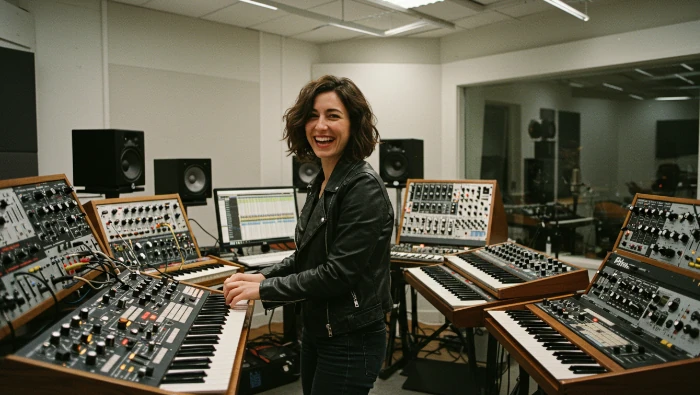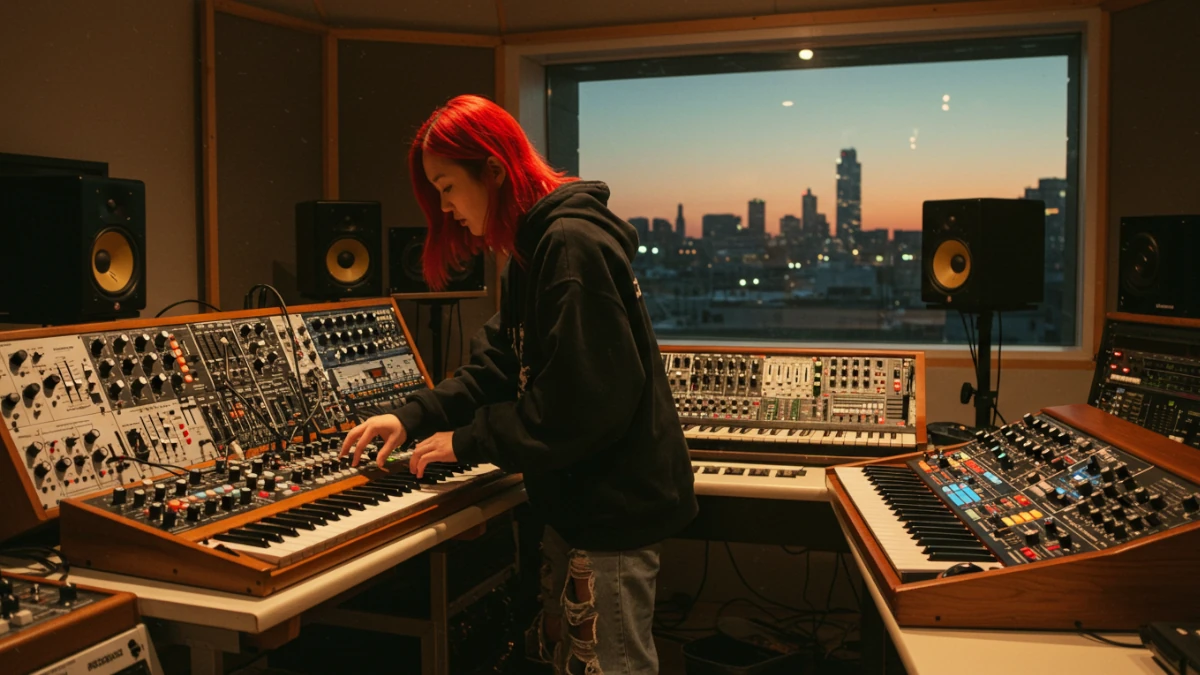Are you ready to tap into a universe where the eclectic sounds of synthesizers and electronic keyboards weave the very fabric of your musical creations? Whether you’re an aspiring music producer or a seasoned sound engineer, understanding how to record synthesizers and electronic keyboards is a game-changer that could transform your beats from good to groovy. Imagine crafting tracks that not only resonate but also linger in listeners’ minds long after the last note fades. By the time you wrap up reading this post, you’ll have actionable insights to set your recordings apart.
Why Synths? The Pulse That Moves Music
Think about your favorite tracks—the pulsating rhythms, the expansive atmosphere, the signature melodies seared into memory. There’s a good chance a synth or two is at the heart of that magic. Synthesizers and electronic keyboards are the chameleons of the music world, seamlessly adapting to any genre, from the deepest techno beats to the chillest lo-fi vibes. If you want to harness the full potential of synths in your recordings, you’re in the right place.
Your Launchpad Into Synth Nirvana
Unlocking the art of recording these versatile instruments isn’t as daunting as it might seem. With the right guidance, anyone can become a pro at capturing everything from thick, lush pads to piercing leads. Dive into our treasure trove of tips and techniques, and get ready to turn your studio into an electronic orchestra. Let’s electrify your music journey and supercharge your productions with synths that’ll make jaws drop and crowds sway.
1. Choosing the Right Equipment: Audio Interfaces and Cables
Embarking on your journey to record synthesizers and electronic keyboards starts with assembling the right gear, and at the heart of this setup are your audio interfaces and cables. These components are crucial as they ensure the sound from your instruments is captured accurately and with high fidelity.
Understanding Audio Interfaces
Audio interfaces act as the bridge between your electronic instruments and your recording software. For synthesizers and keyboards, you want an interface that offers multiple line inputs to accommodate various instruments simultaneously. Popular models like the Focusrite Scarlett 2i2 or the Universal Audio Apollo Twin are excellent choices due to their reliable performance and high-quality preamps, which help preserve the nuances of your sound.
Consider the number of inputs you need. If you’re planning to record multiple devices at once, opt for an interface with enough input channels. For instance, the PreSonus AudioBox USB 96 offers two inputs, which might be perfect for a simple setup, while the TASCAM US-16×08 provides more flexibility with 16 inputs.
The Role of Cables
Cables might seem like a minor element, but they play a pivotal role in audio quality. Choose high-quality TRS or XLR cables for balanced connections, which help minimize noise and interference. Brands like Mogami and Planet Waves are renowned for their durability and superior sound transmission.
Additionally, the length of your cables should be considered. Longer cables can lead to signal loss, so keep them as short as possible without restricting your setup’s flexibility. A good rule of thumb is to use cables no longer than necessary to maintain the clearest signal path.
By carefully selecting your audio interfaces and cables, you’re setting a solid foundation for capturing the rich and diverse sounds of your synthesizers and electronic keyboards. Investing in quality equipment not only enhances your recordings but also saves you from potential headaches down the line.
2. Setting Up a Recording Environment: Acoustic Considerations and Ergonomics
Recording synthesizers and electronic keyboards effectively begins with creating an ideal recording environment. Acoustic considerations and ergonomics play a pivotal role in capturing the best sound possible.
Acoustic Considerations
Acoustics are the backbone of any recording studio. Even though synthesizers and electronic keyboards can be recorded directly without a microphone, the surrounding environment still influences the sound. For instance, reverberation from nearby surfaces can affect the clarity of the playback. To mitigate this, consider using sound-absorbing panels or foam to dampen reflections. These materials help maintain a clean audio signal by reducing unwanted echoes and background noise.
Position your synthesizer away from walls and corners, which can cause sound waves to bounce and create muddiness. This is crucial when you’re monitoring through speakers instead of headphones. For instance, you might notice that certain notes sound more pronounced or muffled, a phenomenon known as room modes, which can be rectified by adjusting the placement of your gear or adding bass traps.
Ergonomics
Ergonomics in your recording setup is about comfort and efficiency. Make sure your synthesizer is at a height that allows easy access to all controls without straining your wrists or back. An adjustable stand can be a game-changer, especially if you switch frequently between sitting and standing positions.
Arrange your MIDI controllers, computer, and other equipment so that everything is within easy reach. This setup minimizes distractions and maximizes creativity. For example, placing your keyboard controller directly in front of your monitor can streamline your workflow, allowing for quick adjustments on the fly.
By optimizing both acoustics and ergonomics, you create an environment conducive to capturing the authentic sound of your synthesizers, leading to high-quality recordings every time.
3. Understanding Sound Design: Tweaking Synth Presets for Recording
Sound design is a crucial aspect when it comes to recording synthesizers and electronic keyboards. This process involves customizing or creating unique sounds that fit the vibe and style of your track. Tweaking synth presets can transform a generic sound into something truly original and captivating.
Why Customize Presets?
Firstly, consider the uniqueness factor. Using default presets can make your track sound too familiar or generic. By tweaking these presets, you can inject your personal touch and stand out in a crowded musical landscape. For instance, let’s say you’re working on a synthwave track. The preset might give you a basic retro sound, but by adjusting parameters like the filter cutoff or resonance, you can shape it into a haunting, atmospheric pad that elevates your song.
Practical Tips for Tweaking Presets
Dive into the synth’s oscillator section first. Altering waveforms can drastically change the sound. Try mixing different waveforms to create a richer texture. Next, explore the filter section. Experimenting with low-pass or high-pass filters can sculpt the sound’s frequency spectrum, making it softer or more piercing.
Real-Life Application Example
Imagine you’re recording a pop track and want a punchy bass sound. Start with a preset that’s close to what you want. Increase the attack to give it more punch, adjust the decay and sustain to control the note length, and tweak the envelope to add dynamics. Case in point: producers like Calvin Harris often start with a preset and modify it extensively to create their signature sound.
Ultimately, the key is experimentation. By spending time with your synth, you’ll develop an ear for what works and what doesn’t, enabling you to craft sounds that resonate with your artistic vision.
4. Recording Techniques: Direct Input vs. Microphone Recording

Recording synthesizers and electronic keyboards can be an exciting journey, and choosing the right technique is crucial for capturing the best sound. Two popular methods to consider are Direct Input (DI) and Microphone Recording. Each has its merits, and selecting the right one depends on your specific needs and the sound you’re aiming to achieve.
Direct Input (DI)
Direct Input is a straightforward and efficient way to record synthesizers and keyboards. This technique involves connecting the instrument directly to the audio interface or mixing console. The primary advantage of DI is its ability to deliver a clean, noise-free signal. For instance, if you’re working with a digital synthesizer like the Korg Minilogue XD, DI ensures that all the rich, digital textures are captured without interference from external noise.
To get started with DI, use a high-quality instrument cable to connect the keyboard output to the DI box or audio interface. Always check your levels to avoid clipping, and consider using a preamp to add warmth if needed. Remember, DI is perfect for capturing the pure sound of your instrument, making it ideal for projects where clarity is paramount.
Microphone Recording
On the other hand, microphone recording is all about capturing the ambiance and character of a room. This technique is particularly useful when you’re using a vintage synthesizer or an analog keyboard with built-in speakers, like a Rhodes Piano. By setting up microphones, you can capture the unique resonance and depth that these instruments produce.
To effectively use microphone recording, set up one or more mics at different distances and angles from the speakers. Experiment with condenser mics for a more detailed sound, or dynamic mics for a warmer, more robust tone. This method can add a layer of authenticity and organic feel to your recordings.
In conclusion, whether you choose DI or microphone recording largely depends on the sound you’re targeting. Mixing both techniques can also yield a rich, textured result, offering the best of both worlds in your recordings.
5. Post-Production: Enhancing Your Synthesizer and Electronic Keyboard Recordings
Once your synthesizer and electronic keyboard tracks have been recorded, the magic of post-production begins. This stage is all about polishing your recordings to give them that professional edge. Think of it as the final touch-up on a masterpiece painting; it’s where your tracks can truly shine.
Refining with EQ and Compression
First, dive into equalization (EQ). By tweaking the EQ settings, you can highlight the frequencies that make your synth sound vibrant and unique while reducing any unwanted noise or muddiness. For instance, if your synth has a rich bass line, a subtle boost in the low-frequency range can add depth and warmth, while cutting some of the mid-range might clear up any clutter.
Compression is another essential tool. It helps manage the dynamic range of your recordings, ensuring that no part of your track is too loud or too soft. This is particularly useful for electronic keyboards where dynamics can vary significantly. A gentle compression setting can bring consistency without squashing the natural expressiveness of the performance.
Adding Effects for Dimension
Effects like reverb and delay can add space and dimension to your synth tracks. A touch of reverb can emulate the acoustics of a room, making your synth sound fuller and more immersive. Similarly, delay can create interesting rhythmic patterns, adding complexity to your track. For example, if you’re working on an ambient track, a long, lush reverb can transform your synth sounds into ethereal soundscapes.
Automation for Dynamic Interest
Automation is your best friend in post-production. It allows you to change parameters over time, adding dynamic interest to your tracks. You could automate the filter cutoff on a synth pad to gradually open up during a chorus, creating a sense of expansion and excitement. Additionally, subtle volume automation can ensure that your synth sits perfectly in the mix at all times.
Incorporating these post-production techniques will turn your raw recordings into polished, professional tracks that stand out. Experiment with different settings and effects to discover what works best for your unique sound. Remember, post-production is as much an art as it is a science, so let your creativity flow!
Conclusion
In wrapping up our deep dive into ‘How to Record Synthesizers and Electronic Keyboards,’ let’s revisit the key takeaways that can elevate your music production skills. First, we delved into the importance of understanding your gear, focusing on both hardware and software synthesizers. Remember, a strong grasp on your instrument’s settings can drastically impact the quality of your recordings.
Next, we highlighted the significance of using the right tools and settings in your DAW to capture pristine sound. Techniques such as layering, EQ adjustments, and reverb usage were discussed to enhance your sonic palette. Moreover, we explored how experimenting with MIDI and audio tracks could unlock a universe of creative possibilities.
Finally, we underscored the value of skilled mixing and post-production techniques to polish your recordings to perfection. Combining various production strategies with a keen ear for detail can transform your electronic music from good to outstanding.
Now, it’s your turn to bring it all together! Start by choosing your favorite synth or keyboard and experiment with the techniques outlined in this guide. Join music production communities, share your experiences, and learn from others. Your journey to becoming a master synthesizer recorder begins today. So, power up your setups, and let those creative juices flow! Remember, the world is waiting to hear your unique sound. Go on, make some magic happen!

